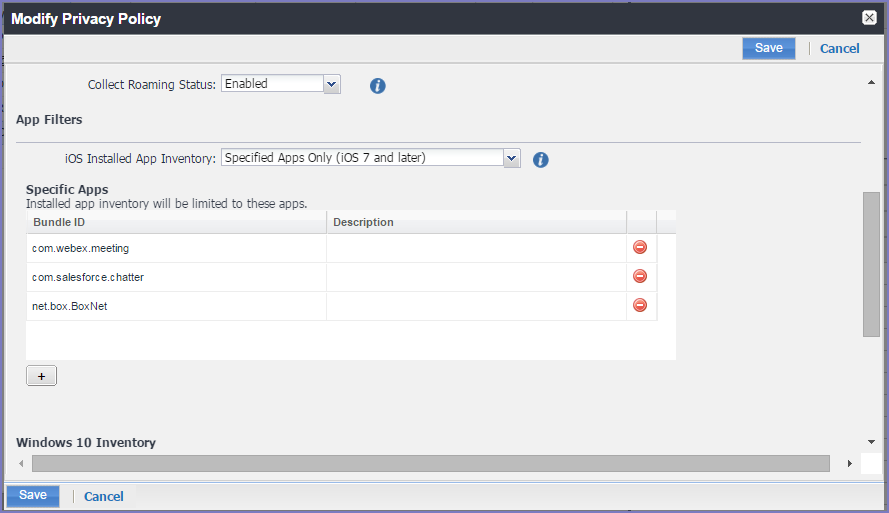Managing installed iOS and macOS apps
Managing installed iOS apps involves:
When Ivanti EPMM is configured for MAM-only iOS devices, you cannot view installed app status.
Viewing the status of installed iOS and macOS apps
The Installed Apps page shows, at a glance, which iOS and macOS apps are installed to managed iOS and macOS devices, respectively. Managed devices send the status of their apps to Ivanti EPMM, and the Installed Apps page indicates the number of devices to which the apps are installed. For instance, if an app has been installed to one managed device, this is indicated by the number 1 and the time stamp for when Ivanti EPMM received the installation status. If a given app has not been installed to any device, that app is not displayed on the Installed Apps page.
You can search for apps using the following:
- Summary View: This search is based on app ID or bundle ID.
- Detailed View: This search is based on the app installation name, meaning the name of the app as installed on a device (as opposed to the App Catalog name, which may be different).
Procedure
- In the Ivanti EPMM Admin Portal, go to Apps > Installed Apps.
- Select iOS or macOS from the Platform list.
-
The list of installed iOS or macOS apps displays the following information in Summary View, including the following columns:
Item
Description
Application Name
The name of the application.
Identifier
The bundle identifier for the application.
Platform
The operating system on which the app is designed to run: iOS or macOS.
Devices Installed
The number of devices to which this app is installed.
First Found
The date and time at which a registered device first reported the app to Ivanti EPMM.
-
To view more details about installed iOS apps, under App Detail, select the Detailed View radio button. The list of installed iOS apps displays in Detailed View, including the following columns:
Item
Description
Application Name
The name of the application.
Identifier
The bundle identifier for the application.
App Version
The version number of the installed app.
Platform
The operating system on which the app is designed to run: iOS or macOS.
Devices Installed
The number of devices to which this app is installed.
Permissions
For Android apps only.
First Found
The date and time at which a registered device first reported the app to Ivanti EPMM.
You can optionally sort the list of apps by any of the available columns.
-
To view details about the devices to which the app is installed, click the number in the Devices Installed column. The Device Details window displays the following information for each device:
Item
Description
Device UUID
The unique identifier for the device.
User Name
The name of the user to whom the device is registered.
User ID
The user ID of the user to whom the device is registered.
Platform
The version of the operating system installed to the device.
Model
The model name and number of the device.
Mobile Number
The mobile phone number associated with the device.
This setting is not displayed for macOS apps.
App Version
The version number of the installed app.
-
You can take any of the following actions on the devices shown here, by selecting one or more devices and then selecting one of the following options:
- Send Message
- Force Device Check-In
- Retire
- Click Apply.
- Click Export to CSV to export the list of devices to a CSV file.
- Click Close.
Selecting which installed iOS apps to track
By default, the App Catalog page lists all apps installed to all managed iOS devices. However, you can filter the types of iOS apps whose installation status you want to log on this page. For example, you can allow Ivanti EPMM to track the status of all apps, or only iOS managed apps, or certain apps specified by their bundle IDs.
Procedure
- In the Ivanti EPMM Admin Portal, go to Policies & Configs > Policies.
- Select the default Privacy policy.
- Click Edit. The Modify Privacy Policy dialog box opens.
- Scroll down to the App Filters section.
- From the iOS Installed App Inventory drop-down list, select one of the following options:
All Apps: Managed devices will send the status of all iOS managed installed apps and unmanaged installed apps to Ivanti EPMM.
The administrator should update the Default Privacy Policy with highest priority and set the "iOS Installed App Inventory" field to "All Apps". This ensures unmanaged apps are reported to the Ivanti EPMM and the Ivanti EPMM can send MDM commands to convert unmanaged apps to managed apps. This applies if the app has the option "Enforce conversion from unmanaged to managed app (iOS 9 or later)" enabled and the unmanaged version of the same app is reported to the Ivanti EPMM.
- Managed Apps Only (iOS 7 and later): Managed devices will only send the status of installed iOS managed apps to Ivanti EPMM.
- Specified Apps Only (iOS 7 and later): Managed devices will send to Ivanti EPMM the status of installed apps (whether iOS managed apps or unmanaged apps) with the specified identifiers (bundle IDs).
-
If you selected Specified Apps Only (iOS 7 and later), a table called Specific Apps displays.
- From the Bundle ID drop-down list, select the identifier for the app you want to track.
- In the Specific Apps table, click the + icon to add the app identifiers whose status you wish to track.
- In the Description field, enter a brief description for the app.
-
To remove an entry, click the delete icon.

-
Click Save.
A prompt displays, indicating that users will receive notification of the changes to the privacy policy.
-
Click Yes.
The default policy is applied to the All-smartphones label and labels to which no other policy has been applied.
Related Topic: